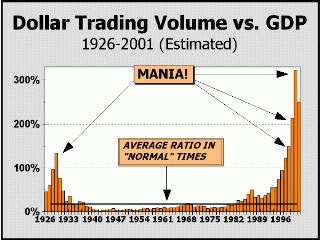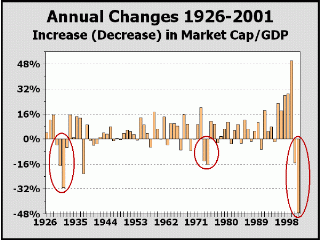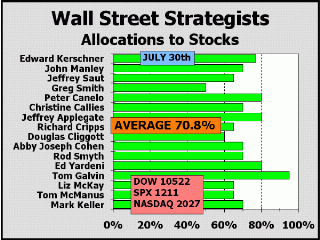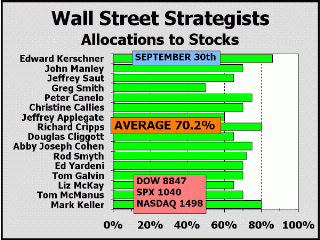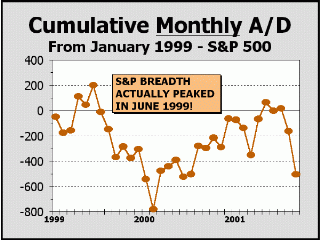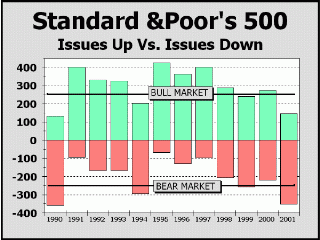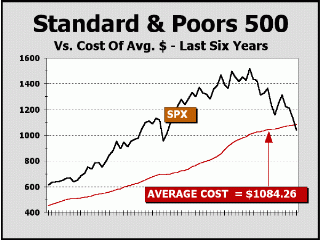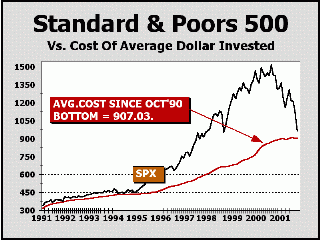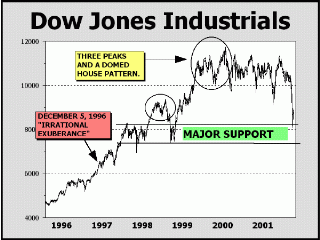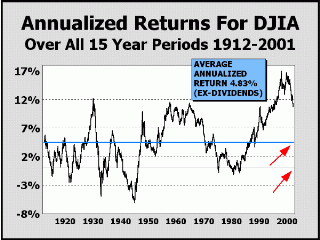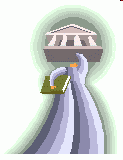
|
CHART DATA AS OF OCTOBER 1, 2001 A SPECIAL REPORT BY ALAN M. NEWMAN, EDITOR LONGBOAT GLOBAL ADVISORS CROSSCURRENTS |
 One sobering view of reality has America in its grip. Another reality continues to be blissfully ignored. The horrible spectacle of the terrorist attack against 6000 innocent souls will haunt all of us for many years to come, but the cohesive efforts of many nations is likely to force a positive resolution versus terrorism at some point. As well, we expect that the Federal government and Federal Reserve Board in concert MAY be able to bring about a more rapid and positive response to the bear market than we previously envisioned. It is entirely too soon to tell whether government efforts will have a "permanent" impact and substantially shorten the secular bear phase for U.S. stocks, but a cyclical bull market could certainly surface within the secular bear market (and possibly from much lower prices). In fact, at this point, although we are still bearish about prospects for 2002, we now have some confidence that 2003 will be an up year for stocks. The wild card is that the mania continues. As long as stocks remain more important than the economy, investors will continue to face the same kind of risks faced at the tops of all prior bull markets. As we have said before, in the final analysis, stocks must be valued on their stream of earnings. A century of experience has shown a multiple of 15 times earnings is a fair price to pay. Nothing that has occurred in the last decade has changed to negate the validity of that view. There is no "new era" and there is no "new economy." All that has changed is the financial industry's refusal to deal with reality.
Dollar Trading Volume has fallen 22% from last year's close and is about 28% lower than the peak reading of 2000. This drawdown is fairly tame in comparison to past bear markets and strongly suggests the mania is still alive and the drawdown has much further to go before the bear market ends. By comparison, DTV slipped 40% in only one year (1974) and cascaded down 82% between 1929-1932. DTV is still 249.1%, meaning that for every dollar spent on goods and services in the economy, $2.49 are spent on trading stocks. The economy was sliding even before the World Trade Center attack and is sliding somewhat faster now. Given that trading has actually increased since the disastrous attack, it is no wonder that the drawdown has been nominal. By our next update, DTV might even increase! Incredibly, the stock market is still the most important facet of the U.S. economy. The Federal Reserve has lowered rates at a faster clip than anytime in our history, in our view, a blatant attempt to keep what remains of the bubble inflated as long as possible. Too much wealth has already been dissipated in the Nasdaq crash and economic health going forward now depends upon stock prices remaining bouyant, if not robust. The need to keep prices inflated is clearly illustrated by our second chart, one of the scariest pictures we have ever shown on these pages. Since the end of 1999, we estimate that total stock market capitalization has imploded by 36.2%, equating to a loss of nearly $6.4 trillion in paper wealth, an amount that translates to about 36% of the Gross Domestic Product generated during the 21-month period. After the crash in 1929, wealth losses compared to GDP were minus 3.8% in 1930, minus 17.3% in 1931 and minus 31.1% in 1932. In the current era, wealth losses compared to GDP are minus 15.3% in 2000 and minus 47.3% thus far in 2001. The impact of this lost wealth may yet turn out to be catastrophic if the public ever loses faith in the long term mantra that is still forwarded as gospel by the financial industry. For at least two years, as our indicators soared to levels that matched and then exceeded the madness of 1929, we warned that we were likely in the midst of the most spectacular stock market mania of all time with all the attendant risk and possible repercussions. Now, as our indicators have plunged to equal and then exceed the pitiful losses of a prior mania, we again feel compelled to warn that the dénouement could be far worse that currently imagined by the majority. No lesser light or legend than Sir John Templeton was interviewed on CNBC yesterday and maintained his view that much of technology is still vastly overpriced. This is most interesting, coming at a time when Nasdaq has to change their own rules about the composition of the NDX index of 100 top Nasdaq stocks. Seems too many of the constituent issues now trade below $1 per share, the exact price at which Templeton spread his bids at the bottom in 1929 on his way towards establishing his well deserved legendary status as a market observer. Templeton is not buying now. ....but Wall Street strategists are.
Anyone who has been on our subscriber rolls for any length of time knows how we feel about the financial industry's cheerleaders, also known as Wall Street Strategists. In short, we have completely lost our respect for this group of market observers, who have apparently lost all ability to predicate their forecasts based on logic or reasonable assumptions of risk. Simply put, the industry standard is now 70% stocks, 25% bonds and 5% cash and woe to those who stray from the course of groupthink mentality. The chart at left appeared in the pages of Crosscurrents on July 30th when the Dow traded at 10416, the SPX at 1205 and Nasdaq at 2029. The chart at right was created on October 1st with the Dow at 8847, the SPX at 1040 and Nasdaq at 1498. The major indexes were clearly much different than before, down 15.1%, 13.7% and 26.2% respectively. However, the chart at right shows almost no collective difference in stock allocations at all! Before, the average allocation to stocks was 70.8%. And now, the average allocation to stocks is 70.2%. Then, the average allocation to cash was 4.4%, now it is 4.9%. All the damage of the last few months has resulted in virtually no movement or concern. In fact, as stocks hit their highs in May, allocations to stocks were at 69.8% and allocations to cash were 5.7%. So, between the May highs and today, allocations remain basically the same as before, but with the notation that not as much cash remains available to fuel whatever additional buying strategists would have investors do at these "cheap" prices. In fact, average allocations to cash have plunged considerably since the March 24, 2000 peak, when strategists maintained reserves of 11.6%. Typically, in times past, lower prices translated into more fear and conservativism and strategists increased cash and reduced stock allocations. Not now. The long term mantra has been recited so often that even strategists believe it! Since the March 24, 2000 price peak of 1553 for the SPX, allocations to stock have increased from 61.5%. Strategists have bought almost every step of the way down. This is additional proof that the mania lives on. Although we have finally seen some "capitulation" by newsletter writers, moving to a net bearish position for the first time in three years, this is virtually the only area in which there appears to be a widening recognition of the scope of the bear market. For a really good laugh, you might try the Wall Street Week elves. Here, the record is so sorry that a random choice of a bull, bear or neutral stance would have worked better than the elves' seemingly permanent bullish posture! As far as professionals are concerned, every bottom has been a buy, each one lower than the one before, and last month's bottom has been no different. The talking heads on CNBC are still not asking the important questions of strategists and are too quick to present and spin the positives. The long term odds will remain heavily in
favor of the bears until strategists
Much has been made of recent oversold conditions, as analysts point to the inevitability of a huge rebound as a minimum condition. Although many shorter term indicators are indeed at levels they have been a mere handful of times in the past, the oversold condition does not preclude further damage by itself. Rather, given the circumstances of continuing blanket calls to buy the market by professionals, recent weakness is likely a testament to how vulnerable the market truly is. Longer term indicators present much different perspectives than short term indicators. Cumulative monthly breadth peaked for the S&P 500 way back in June of 1999 and is now well above the February 2000 lows. As S&P 500 breadth peaked on the last day of June 1999, the index closed at 1372 and actually ran as high as 1441 in February of 2000 when breadth bottomed! The divergence was the most negative this observer can remember, testament to fewer and fewer individual constituent issues driving the index. Action since then confirms the peak in June of 1999. When breadth again peaked in May 2000, the SPX closed only as high as 1461 and actually closed the month at 1420. Clearly, less stocks accounted for any remaining bouyancy in the index. If we revisit and "test" the 2000 lows in breadth, much lower prices will result. Is there a better illustration of a bear market than we show below right? Thus far, 352 constituents of the S&P index are down for the year, versus 359 in 1990. Amazingly, with more than 70% of the entire index behind the eight-ball, many observers seem relatively unfazed. Even those market letter writers we referred to before, those folks who have finally moved to a net bear position, are relatively unscathed by recognition compared to 1990. Early that year, bears climbed to near 58% and again soared as high at 57% as the Iraqis threatened Kuwait. The recent move to 42.1% bears seems quite tame by comparison. In 1990, recognition of the bear market was quite widespread. Eric T. Miller of Donaldson, Lufkin & Jenrette was quoted on September 27th, "I see no clear signs of a bottom." Rich B. Hoey of Barclays de Zoete Wedd was quoted on October 8th, "If you believe we are in a full-scale recession, then avoid losing money by staying out of the stock market." Carmine Grignoli of First Boston Corp. was quoted on October 22nd, "The market still seems vulnerable." We could go on and on. In 2001, the only talk by strategists is of yet another "bottom!"
Investors have clearly received the shaft from Wall Street's insistence that they heed the long term mantra. Buy and hold! The advice to hang in at all times has never been correct. Just as buying an index fund relegates one to the bad companies as well as the good, "staying the course" condemns one to the bad times as well as the good. We can't think of another period in which the public has been given worse counsel by so-called professionals. As shown at left, through September, investors who have laddered into stocks over the last six years are now behind and losing money! This is about as awful a reminder as one might imagine that stock prices go down as well as up. Given dividends and/or the reinvestment of same, we freely admit the results are better but the paucity of dividends over the last six years at an average of 1.4% annually has afforded no real cushion for investors. Investors are back to square one! Going as far back as the bear market bottom of 1990 affords another scary perspective, illustrating how close investors are now to giving up all their the gains from the last eleven years, the entire bull market measured from 1990! At the September 21, 2001 close of 965.80 shown on our second chart, investors who had laddered in since the beginning of the bull market were ahead by only 6.5%. At the September 21st print low of 944.75, they were ahead by a mere 4.2%. At the September 30th close of 1040.94, investors were ahead by only 14.8%, equivalent to a compounded rate of less than 1.3%! So much for the long term mantra.
We showed this Dow Industrials chart earlier in the year and we showed the S&P 500 as well, delineating potential support and zones we believed would be tested. Given the substantial break below our downside targets, an update is in order. The pattern leading to the highs is known as "Three Peaks and a Domed House," a pattern (see highlighted oval) discovered by George Lindsay. Lindsay believed the pattern could be found at the end of long sustained bull markets and he used it to predict a peak in the Dow at the end of October 1968. Although the Dow actually peaked at 995 in late 1968 and traded nominally above that level in the early 70's, the broad market had already peaked before the domed house was "built" and 1973-1974 witnessed the worst bear market since the Depression. We have labeled the area of the 1997 consolidation and 1998 breakout as major support for the Dow. Although recent action can be construed as a successful test, we believe the test is not yet sufficient to sound an all-clear. We had hoped that the circled area, which functioned as a consolidation after the late 1998 breakout, would act as support as it did earlier in 2001. The break below those levels is sufficiently large to require repeated testing of the 1998 bottom. We believe another test of these levels is liable to surface soon and we are currently attempting to guage the odds for a further downside next year. Ironically, if our "major support" fails, the next level of major support might be precisely the place at which FRB Chairman Alan Greenspan gave his "irrational exuberance" speech in December 1996 at Dow 6437. Given how high 15-year returns still are, further price declines are quite probable in the next few years. These returns peaked at 16.6% in 1999, giving Wall Street all the ammunition it required for the constant repetition of the long term mantra. However, as the second chart clearly illustrates, over the course of time the average 15-year return has been less than 5% (ex-dividends). The 70% crash in Nasdaq and 30% clipping in the S&P 500 is reason enough to believe there is no "new era" or "new economy" that will prohibit a return to normal parameters at some point. Of course, we do not expect a return to historical parameters to surface overnight. On the contrary, we expect a return to "normal" to take several years. For the 15-year return to fall to normal at 5% (see higher arrow), the Dow would need to trade at 6200 five years from now! Crazy? Since a return to "normal" would also result in the Dow at 12,450 a decade from now, this is probably as normal as assumption as one might make. The worst case scenario would likely see 15-year returns plummet to zero (see lower arrow). This is not a totally unreasonable assumption as 15-year returns have been at or below zero more than 13% of the time. The equivalent ten year target for a zero percent return is 5685! The longer the mania continues, the higher
the odds will remain
We invite you to stay tuned for our next report, in which we will focus on the seasonal patterns that could alleviate investor pain for awhile and we hope to take our first look at the possibilities for 2002 and 2003. Our short term indicators functioned perfectly, allowing us to correctly forecast the test and break of the March 2001 lows for stocks. Incredibly, the big swing towards bearish sentiment we hoped for has not taken place. Yes, newsletter writers are now more bearish but Wall Street strategists remain confident of yet another bottom. As we said in the September 24th issue of Crosscurrents, "1000 points are available for the taking in either direction." But much of the potential for the upside may have already occurred. The best bottoms usually occur after a retest. Even if September 21st was a significant bottom, it should be tested and sooner, rather than later. The continued bullish stance of strategists is proof that capitulation has not yet occurred. Until it does, we have great difficulty with bullish prospects for the intermediate term. However, if a retest or break of the lows occurs, we may turn bullish for awhile. Our downside targets
for 2001 were achieved!
Thank you for viewing this site, which is usually targeted for an update approximately every six weeks. We expect to update next by the third or fourth week of November 2001, but please be advised that personal and professional commitments may delay the update for a further two weeks. We urge you to stay tuned and tell your friends. In the meantime, please be our guest and return to the other sections of our site to view the updates of our other features. If you haven't seen them before, the Commentary, Chart of the Week and Short Term Outlook pages should be of further interest. Alan M. Newman, October 3, 2001 All information on this website is prepared from data obtained from sources believed reliable, but not guaranteed by us, and is not considered to be all inclusive. Any stocks, sectors or indexes mentioned on this page are not to be construed as buy, sell, hold or short recommendations. This report is for informational and entertainment purposes only. Longboat Global Advisors, Alan M. Newman and or a member of Mr. Newmanís family may be long or short the securities or related options or other derivative securities mentioned in this report. Our perspectives are subject to change without notice. We assume no responsibility or liability for the information contained in this report. No investment or trading advice whatsoever is implied by our commentary, coverage or charts. |
